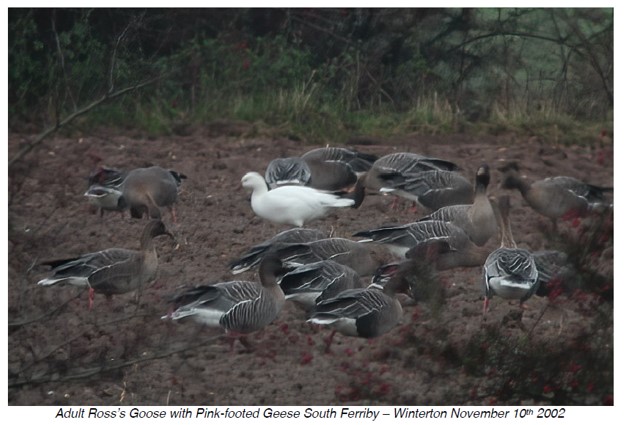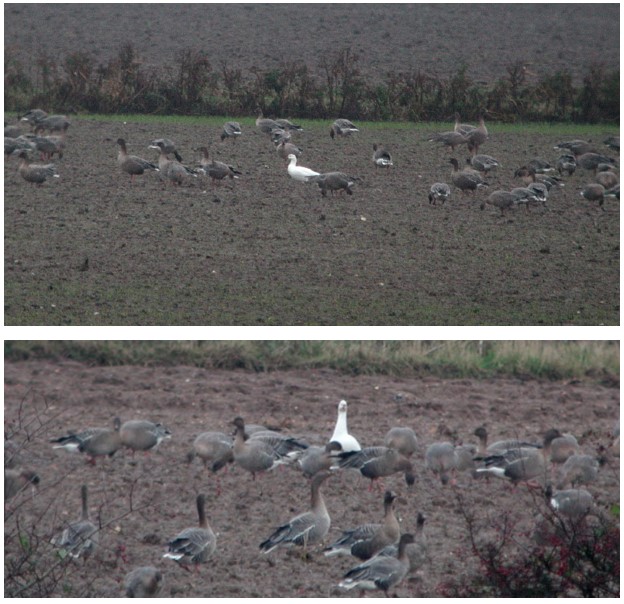With the imminent acceptance of the Lincolnshire Ross’s Goose (likely to be upgraded to Cat A by BBRC as BOU have now admitted Ross’s Goose to the British List…), and as noted in the recent BB magazine, Graham Catley has added some images (all digi-scoped in crap weather…), to the original article that he wrote (in 2002) and that appeared in the Lincs 2000 - 2002 Report (there were no images just the text in the original publication).
The Ross’s Goose at Read’s Island, South Ferriby and Winterton on November 10th 2002; a new bird for Lincolnshire.
Since 1960 the Wildfowl and wetlands Trust have organised an annual census of Icelandic grey geese, Pink-feet and Icelandic Greylags which is undertaken in October and November. Counts are co-ordinated over one weekend in the first half of October and November to maximise the chances of recording the peak totals of each species as they arrive from their Icelandic breeding grounds.
Having noticed that the Humber roost was not being monitored I volunteered to undertake the counts from the early 1990’s and have done the two counts each autumn since then along with supplementary counts throughout the winter. The second count of the 2002 season was organised for November 9-10th, a dusk roost count or a dawn departure count are allowed depending which
is the most suitable at your roost. The forecast of heavy rain and wind on the morning of the 10th sent me to my count site opposite Read’s Island on the evening of the 9th although I knew from past experience that roost counts were difficult at this site as birds often arrive very late, sometimes in total darkness. By 17:00 only 390 birds had moved onto the island but there were two flocks of
410 and 340 on fields just to the south of my count position. At 17:05 it was just about dark and I was about to give up when a loud goose chorus alerted me to a flock of 900 birds arriving from the south-west, including the 340 above. Shortly after another huge flock came in from high to the south-east but were hard to see in the darkness; even so I estimated there were 2400 plus birds but how many had I missed. There was nothing for it but to set the alarm for 06:00 the following morning and brave the rain.
By 06:30 on the 10th I was again in the lay-by opposite Read’s Island and although there were frequent heavy showers and it was a truly grey day with a strong south-east wind it was not as bad as I had expected! At 06:58 the first geese started to leave their roost and with the poor weather flew low south and landed on the fields behind me. Flocks then started to stream out from the roost and counting was difficult in the wind and increasing rain. Then in the gloom there was a sight for straining eyes, a snow goose, unmistakable white morph bird with immaculate black wing tips. The flock it accompanied looked as if they were going to land on the fields about 600m away but I was still trying to concentrate on continuing to count the never ending flocks of Pinks. By 07:10 I managed to phone a few people and put the word out knowing that the geese would probably not stop on these fields for long before dispersing inland. After a few more minutes when the flocks seemed to have stopped leaving the roost I was able to put up the scope and have my first good look at the snow goose. Even on a first glance, having seen many thousands of both Lesser Snow and Ross’s in California in winter, it was clear that this was not a Snow but a diminutive Ross’s! It was smaller than the Pinks next to it and the short, thick neck, stumpy bill and rounded head quickly identified it as a standard Ross’s. A quick check revealed that the long looking legs carried no rings.
Fortunately, as the majority of the geese moved off after being shot at by the local farmer, the Ross’s returned with a small flock of Pinks and fed on the autumn cereals in the field immediately west of South Ferriby Cement works for the next four hours during prolonged spells of heavy rain.
At lunchtime it moved with a large flock of Pinks onto a field of sugar-beet tops north of Winterton show ground where it showed very well until mid-afternoon when the flock flew off and it was not relocated. During observations of the flock at Winterton a fine Tundra Bean Goose was found in the flock and at times both this bird and the Ross’s were in the same scope view.
Description:
A small goose, smaller in overall proportions than the accompanying Pink-feet, a feature that was very noticeable in flight. Bill short and stumpy, pink with purple/grey marks at the base where it joined the head feathering in a vertical line; no grinning line as in Lesser Snow. Head rounded and neat with a gentle impression formed by the small bill and the dark eye in the rounded head. Neck quite short and usually looked thick, thicker in proportion than Pinks, but longed when stretched up when agitated. All of plumage white but for tips of wings, primaries, which were black. Legs quite long looking and both legs and feet pink.
So why was there so little interest in this bird from Lincolnshire birders? At present the species resides in Category D of the BOU British list on the general principal that the likelihood of escapes occurring is more likely than wild birds. This categorisation has been increasingly questioned in recent years however, with the increasing occurrence of the species in wild carrier flocks of Pink footed Geese that have also started to bring with them vagrant Canada Geese in increasing numbers. The record of a first-winter Ross’s with Pink-feet in Norfolk in the 2001-2002 winter, returning in 2002-2003, rekindled the debate on the origin of Ross’s Geese in the UK. Yes there are a lot of birds in captivity but birds like this individual are arriving with large flocks of Pink-feet from Iceland and Greenland and there seems no reason to doubt that they are indeed wild birds.
The number of Greenland White-fronted Geese that are occurring in eastern England is also increasing again suggesting an origin for many of the vagrants in Greenland or further west? There have been the first proven records of Greenland White-fronts with the Humber Pinks in the last two winters while a Pale-bellied Brent wintered with them in 1998-1999. The Nearctic population of
Ross’s and Lesser Snow Geese has increased from an estimated 900,000 in 1970 to an estimated 5.12 million by 1998 (Birding World 14:11:477) with the population of Ross’s possibly now being as high as 1 million birds. As stated in the Birding World paper (Ross’s Geese in Britain 14:11:475) ringed Lesser Snow and vagrant Canada Geese have occurred in the UK so it seems a bit silly to suggest that wild Ross’s cannot be occurring.
On the morning of the 11th I again counted the geese departing from the roost and in much better conditions than on the previous day the total of 4620 birds formed an amazing spectacle but there was no sign of the Ross’s Goose; had it moved on to Norfolk the previous afternoon? This is the highest count on the Humber since the winter of 1969-70 and forms part of the recent trend for
increasing numbers that has been noted since the early 1990’s. As there are now so many geese they are splitting into smaller flocks and travelling much further from the roost site than in previous winters making them more difficult to observe and keep tabs on but I will be devoting a bit more time to the flock over the coming weeks!
Graham Catley All images © Graham Catley











